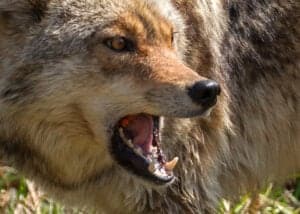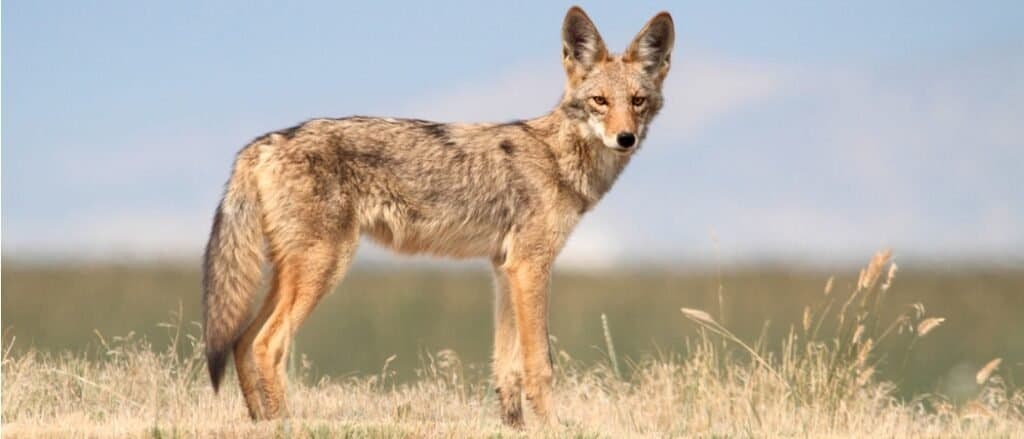
Coyotes weigh between 20 and 50 pounds on average
©iStock.com/SteveByland
There is a wide range of sizes among coyotes, but they are medium-sized canines. Running dogs, these slender animals weigh between 20 and 50 pounds. Coyote size can be affected by a variety of factors, including gender and age.
The typical length of a coyote, including the tail, is about forty-eight inches. On average, they are between 21 and 24 inches tall, depending on gender. These dimensions are comparable to those of a medium-sized pet dog.
How Big Do Coyotes Get?

A full-grown coyote is around 3 feet long and 2 feet tall.
©Jim Cumming/Shutterstock.com
When fully grown, a typical coyote is around 3ft long and a little over 2ft tall. The average weight of an adult coyote is around thirty pounds. In general, males tend to be larger and heavier than females, but there are exceptions.
Wild coyotes weighing 60, 80, and even one hundred pounds have been seen, according to some sources. Coyote size can vary depending on several factors, including how healthy it is.
How Much Do Coyotes Weigh?

Female coyotes are typically smaller than males, although Alpha females can be larger than their beta counterparts.
©Jukka Jantunen/Shutterstock.com
Coyotes can grow to be between twenty and fifty pounds as adults. Healthy newborn puppies should weigh eight to ten ounces or about half a pound. Gender-based differences in body mass mean that women typically weigh less than males.
A coyote’s weight may be affected by its place in the social order. The huge size of a coyote can be used to identify male and female alphas. Solitary coyotes may be undernourished and weigh less than coyotes that are living in groups.
Are Male and Female Coyotes the Same Size?
In terms of both height and weight, female and male coyote sizes differ, with female coyotes being smaller and lighter than males. At 21-22 inches tall, female coyotes are two or three inches shorter than males.
Female coyotes often weigh 10 to 15 pounds less than males, but this isn’t always the case. Alpha females tend to be larger than their male counterparts because they eat more frequently and consume more calories. This means that a healthy pack is one that has large alphas and large betas.
How Big Are Coyote Pups?
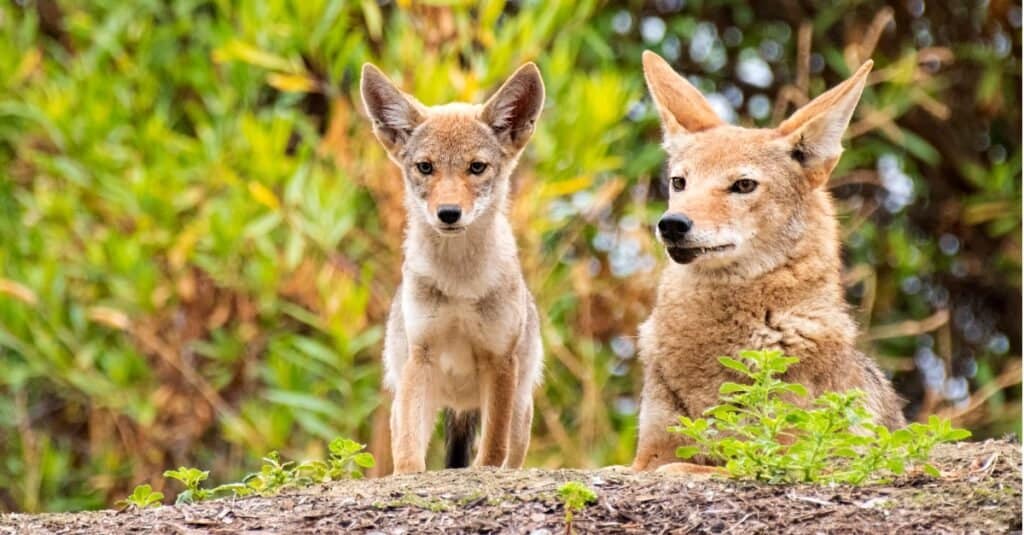
When born, coyote pups weigh less than a pound. Throughout their first year of life. they will gain up to 20 pounds.
©iStock.com/roclwyr
The first year of a coyote’s life is devoted to developing their hunting and social skills.
When they are born, coyote pups weigh less than a pound. Over the course of nine months, a puppy’s weight might rise to between 15 and 20 pounds. At the age of nine months, all a coyote’s teeth have erupted. The coyote devours protein and hunts during the first 12 months of its life. Coyotes reach their full size at 12 months of age.
Coyote Size Compared to Other Animals
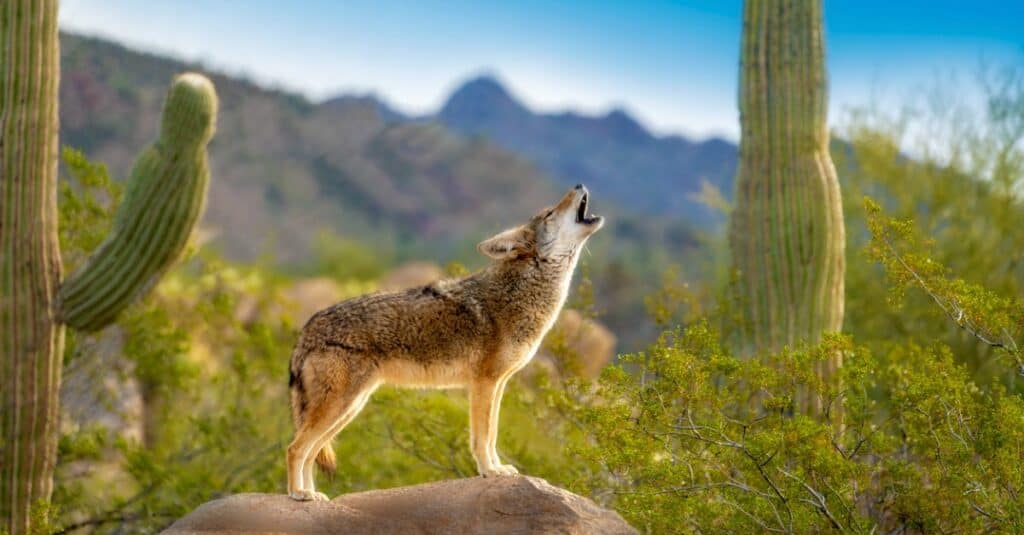
Because coyotes are smaller than wolves, they can even be mistaken as prey by the wolf.
©JayPierstorff/Shutterstock.com
Coyotes are medium-sized predators many predators of their own to look out for. Because of their smaller frame, mountain lions, wolves, and bears often mistake coyotes for prey. Coyotes tend to avoid conflict with larger counterparts, such as wolves. They keep the size of their packs stable by avoiding confrontation as often as possible.
Coyotes prey on much smaller animals such as rabbits, mice, and other rodents. Farmers deal with coyotes coming onto their land quite often. If you have a coyote problem, there are many humane ways to keep them away from your property, including secure fencing.
Coyote Size Compared To Wolves

Compared to wolves, coyotes are much leaner animals. With a height of 26 to 32 inches, the average wolf in the United States weighs between 50 and 110 pounds.
The coat colors of these two animals are remarkably similar, yet the facial features are very distinct. In comparison to its head size, the coyote has a short nose pad and a narrow snout. The wolf has small ears for its enormous head, a broad snout, and a thick nose pad.
During the summer and fall, wolf pups can look so much like coyotes that it’s difficult to tell them apart. A young coyote, on the other hand, is much smaller than a young wolf. Because of this, the wolf will grow and mature more swiftly.
The obvious size difference between wolves and coyotes may be seen in the size of their paws. The nails on a wolf’s paws can grow to be up to five inches long. An adult coyote can grow its paw to only three inches in length.
Coyote Size Compared To Dogs

Coyotes are comparable in size to a medium-sized dog breed such as the
Border Collie
or
Dalmatian
.
©FRAYN/Shutterstock.com
In terms of body mass, coyotes are comparable to medium-sized domestic dogs. Coyotes and medium dogs share a weight range of 20-60 pounds.
Here are five well-known canine breeds whose stature is comparable to that of a coyote:
- Border Collie
- Corgi
- English Cocker Spaniel
Coyote Size Compared To Foxes
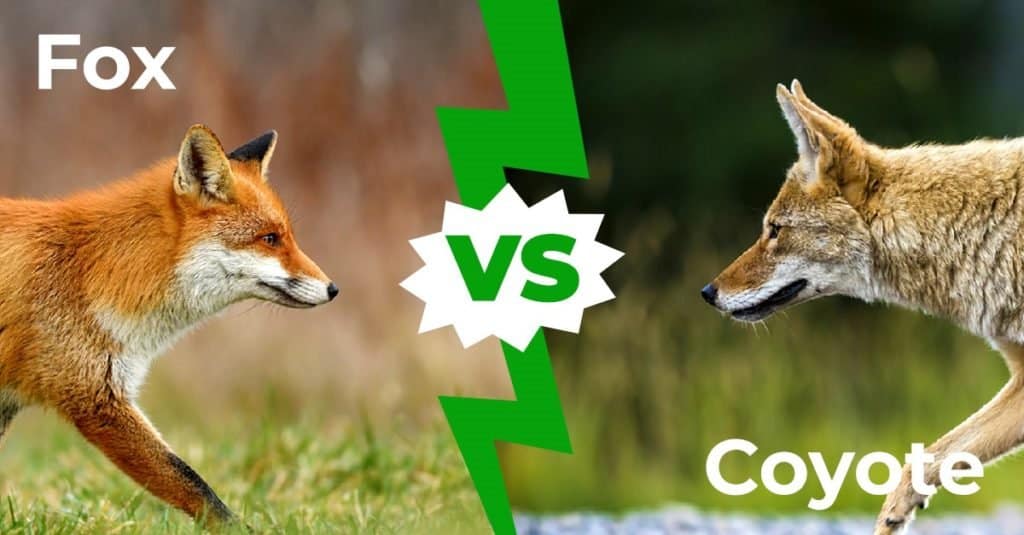
Coyotes are bigger than foxes in terms of height, weight, and length. Foxes weigh only up to 15 lbs. on average. Coyotes and foxes are visually distinct species. Coyotes have much longer limbs and stand much taller off the ground. Coyotes also have much larger paws. Coyote pawprints are three inches long, nail markings included. Fox pawprints are only half this size.
The photo featured at the top of this post is © iStock.com/SteveByland
Thank you for reading! Have some feedback for us? Contact the AZ Animals editorial team.



